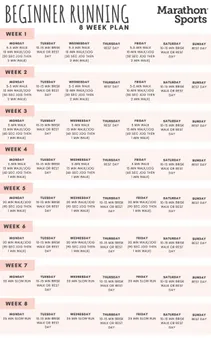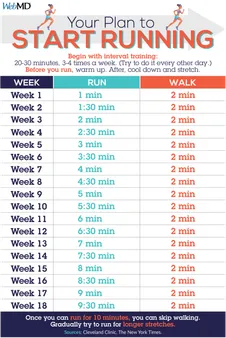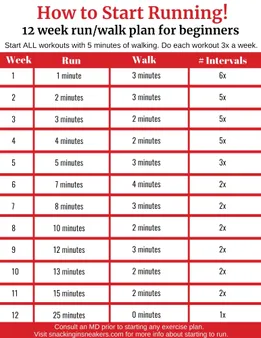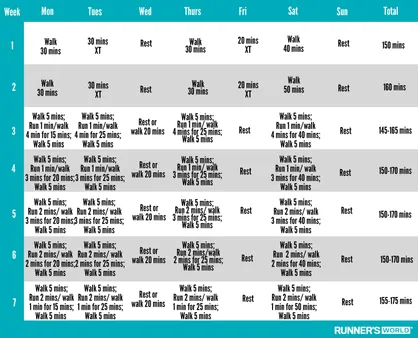Table of Contents
Embark on a healthier lifestyle with Kizworld and discover How to start running for beginners. Running offers a wealth of benefits, from improved cardiovascular health and weight loss to enhanced mood and stress reduction. Whether you're a complete novice or looking to reignite your running journey, this comprehensive guide provides everything you need to know to get started. From choosing the right running shoes to creating a personalized schedule and staying motivated, we'll guide you every step of the way. Lace up your sneakers and prepare to experience the transformative power of running with kizworld.
How to Start Running for Beginners: A Comprehensive Guide to Get You Moving
I. Establish Necessary Readiness
Establish Necessary Readiness
Before setting foot on the pavement, it's crucial to ensure you're prepared for the journey ahead. Fortunately, with a bit of planning and preparation, you can set yourself up for success. Read How to Get Started with Running as a Beginner to learn more.
Start by consulting your doctor for a checkup, especially if you have pre-existing health conditions. They can assess your overall health and provide guidance on how to safely incorporate running into your routine. Check out The Benefits of Running for Health and Wellness for more information.
Next, invest in a quality pair of running shoes. These should provide adequate support, cushioning, and flexibility to protect your feet and joints during your runs. Refer to How to Choose the Right Running Shoes for helpful tips.
Don't forget to dress in comfortable, moisture-wicking clothing that will keep you dry and prevent chafing. Consider the weather conditions and choose appropriate layers. Check out The Best Running Clothing and Apparel for recommendations.
Task | Significance |
Medical Checkup | Ensures you're healthy enough to start running. |
Proper Footwear | Protects your feet and joints. |
Appropriate Clothing | Enhances comfort and prevents chafing. |
Start with Walking: A Foundational Step
Beginning your running journey with walking is an excellent way to build a solid foundation. Walking helps improve your cardiovascular health, strengthens your muscles, and prepares your body for the transition to running. Gradually increase the duration and intensity of your walks until you feel ready to incorporate short running intervals.
Remember, starting slowly and gradually increasing your distance and intensity is key to preventing injuries and sustaining a lifelong love for running. Patience, persistence, and a positive attitude will take you far on your running journey.
- Begin with walking to build a strong foundation.
- Gradually increase walk duration and intensity.
- Incorporate short running intervals when ready.
- Start slowly and increase distance and intensity gradually.
- Maintain patience, persistence, and a positive mindset.
II. Master the Fundamentals of Running
Master the Fundamentals of Running
Proper Running Form
Maintaining proper running form is crucial for preventing injuries and maximizing your running efficiency. Here are some key elements of good running form:
- Upright Posture: Keep your head up, shoulders relaxed, and back straight. Avoid leaning forward or hunching over.
- Midfoot Strike: Land on the midfoot, not the heel or toes. This helps absorb shock and reduces stress on your joints.
- Short, Quick Steps: Take shorter, quicker steps rather than long, bounding strides. This will help you maintain a consistent pace and reduce fatigue.
- Arm Swing: Swing your arms naturally at your sides, keeping your elbows bent at a 90-degree angle. This helps maintain balance and momentum.
- Relaxed Hands: Keep your hands relaxed and slightly cupped. Avoid clenching your fists or tensing your arms.
Remember, proper running form takes practice. Focus on these elements and gradually improve your technique over time.
Creating a Running Schedule
Consistency is key when it comes to running. Creating a running schedule will help you stay motivated and track your progress. Here are some tips for creating a running schedule:
- Set Realistic Goals: Start with a manageable goal, such as running for 30 minutes three times a week. Gradually increase your distance and frequency as you get stronger.
- Choose a Schedule that Fits Your Lifestyle: Make sure your running schedule fits into your daily routine. Whether you prefer early morning runs or evening jogs, find a time that works for you and stick to it.
- Include Rest Days: Rest days are essential for recovery and preventing injuries. Schedule at least one rest day per week, or consider active recovery activities like yoga or swimming.
- Mix Up Your Runs: To keep your runs interesting and challenging, vary your routes and incorporate different types of runs, such as tempo runs, interval training, and long runs.
- Listen to Your Body: Pay attention to how your body feels during and after your runs. If you experience pain or discomfort, take a break and consult with a healthcare professional.
By following these tips, you can create a running schedule that helps you achieve your fitness goals safely and effectively.
Discover the Health Benefits of Running
Nutrition for Runners
Proper nutrition is essential for fueling your runs and supporting your overall health. Here are some key nutritional considerations for runners:
- Carbohydrates: Carbs are your body's primary source of energy. Eat plenty of whole grains, fruits, and vegetables to ensure you have enough fuel for your runs.
- Protein: Protein is essential for muscle repair and growth. Include lean protein sources, such as chicken, fish, beans, and tofu, in your diet.
- Healthy Fats: Healthy fats, found in foods like avocados, nuts, and olive oil, help support overall health and provide sustained energy.
- Hydration: Staying hydrated is crucial for preventing dehydration and maintaining optimal performance. Drink plenty of water before, during, and after your runs.
- Supplements: While a balanced diet should provide most of the nutrients you need, some runners may benefit from supplements like iron, calcium, or omega-3 fatty acids.
Consult with a registered dietitian or healthcare professional to create a personalized nutrition plan that meets your individual needs and goals.
Explore the Best Nutrition and Hydration Strategies for Runners
III. Execute a Beginner-Friendly Running Plan
Execute a Beginner-Friendly Running Plan
Gradual Progression: Start Slow and Increase Mileage
To avoid injury and maintain motivation, begin with a manageable distance and gradually increase your mileage over time. Start with 2-3 runs per week, keeping the distance around 1-2 miles per run. Gradually add 10-15% to your weekly mileage each week, ensuring your body has time to adapt and strengthen.
Week | Number of Runs | Distance per Run (miles) |
|---|---|---|
1 | 2-3 | 1-2 |
2 | 2-3 | 1.1-2.2 |
3 | 2-3 | 1.21-2.42 |
Incorporate Walking Breaks:
If running continuously feels challenging, incorporate walking breaks into your runs. Start with a 1:1 ratio of running and walking, where you run for one minute and then walk for one minute. As you progress, gradually increase the running intervals and decrease the walking intervals.
- Combining running and walking can help you build endurance and prevent burnout.
- Gradually reduce walking intervals as your fitness improves.
Monitor Your Pace:
While running, focus on maintaining a comfortable pace that allows you to hold a conversation without feeling out of breath. Avoid sprinting or pushing yourself too hard, as this can lead to injuries and decrease your overall running enjoyment.
- Listen to your body and take rest days when needed.
- Running should be enjoyable, not a race against time.
Cross-Training Activities:
Include cross-training activities, such as swimming, cycling, or yoga, into your weekly routine to enhance your overall fitness and reduce the risk of overuse injuries. Cross-training can also improve your running performance by strengthening different muscle groups and improving cardiovascular health.
- Cross-training activities can help prevent boredom.
- These activities can improve your overall fitness and reduce injury risk.
Stay Hydrated:
Staying hydrated is crucial for maintaining optimal running performance and preventing dehydration. Drink plenty of water before, during, and after your runs. Carry a water bottle or use a hydration pack to ensure you have easy access to fluids while running.
- Dehydration can lead to fatigue and decreased performance.
- Proper hydration supports your body's natural cooling mechanisms.
Listen to Your Body:
Pay attention to how your body feels during and after your runs. If you experience any persistent pain or discomfort, take a break and consult with a healthcare professional to rule out any underlying medical conditions or injuries. Remember, rest and recovery are essential parts of the training process.
- Ignoring pain or discomfort can lead to injuries.
- Rest and recovery are crucial for progress.
IV. Monitor Progress and Make Necessary Adjustments
Monitor Progress and Make Necessary Adjustments
Consistency is key when it comes to running. To see progress and reach your goals, you need to stick with your running routine and track your progress. Here are some tips to help you monitor and adjust your running program:
- Set Clear Goals: Clearly define your running goals. Whether it's improving your speed, endurance, or completing a certain race, having specific goals will help you stay motivated and track your progress.
- Keep a Running Log: Maintain a detailed running log to record your runs. Include information like distance, time, pace, and how you felt during and after your run.
By regularly monitoring your progress, you can identify areas where you need to make adjustments. For instance, if you're struggling to maintain a consistent pace, you may need to incorporate more speed work into your training. On the other hand, if you're experiencing pain or discomfort, you might need to adjust your running form or take rest days.
Sign | Possible Cause | Recommended Adjustment |
Frequent Injuries | Overtraining, improper form | Reduce mileage, work on form, consult a coach |
Stagnant Progress | Lack of challenge, insufficient recovery | Increase intensity or distance, adjust rest days |
Loss of Motivation | Monotonous routine, lack of goals | Try new routes, set new goals, join a running group |
It's also important to listen to your body and take rest days when needed. Overtraining can lead to injuries and burnout, so make sure to incorporate rest and recovery into your training schedule.
Remember, progress in running is gradual. Don't get discouraged if you don't see immediate results. Stay patient, stay consistent, and keep making necessary adjustments along the way. With dedication and persistence, you'll achieve your running goals and unlock your full potential as a runner.
As you continue your running journey, consider joining our community of runners at kizworld.vn/running to connect with like-minded individuals, share your experiences, and learn from others who share your passion for running.
For more in-depth guidance on running, check out our comprehensive article on How to Start Running for Beginners.
V. Conclusion
As you embark on your running journey, remember that progress takes time and consistency. Don't get discouraged if you don't see immediate results. Keep at it, and you'll be amazed at how far you've come. Running is a lifelong pursuit that offers countless rewards, both physically and mentally. Embrace the challenge, enjoy the process, and let kizworld be your guide as you strive to become a healthier and happier runner.